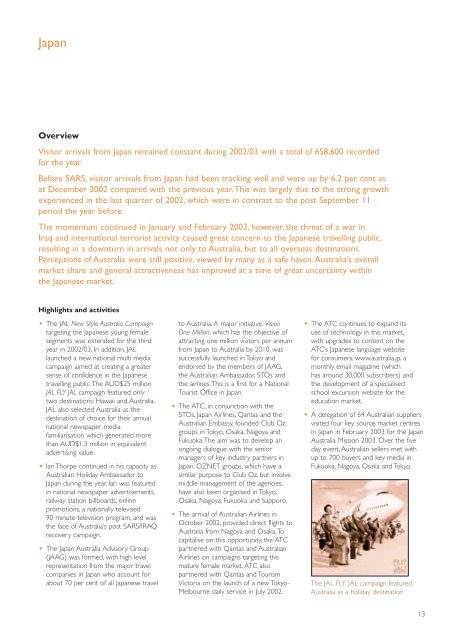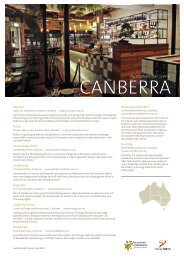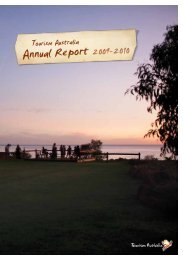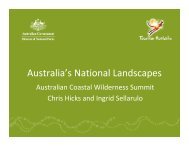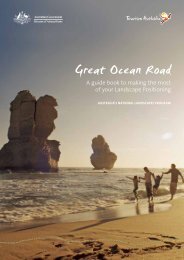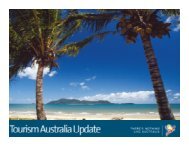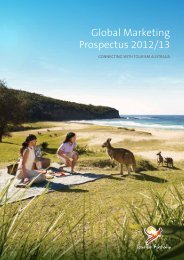2002 - 2003 Annual Report - Tourism Australia
2002 - 2003 Annual Report - Tourism Australia
2002 - 2003 Annual Report - Tourism Australia
You also want an ePaper? Increase the reach of your titles
YUMPU automatically turns print PDFs into web optimized ePapers that Google loves.
Japan<br />
Overview<br />
Visitor arrivals from Japan remained constant during <strong>2002</strong>/03 with a total of 658,600 recorded<br />
for the year.<br />
Before SARS, visitor arrivals from Japan had been tracking well and were up by 6.2 per cent as<br />
at December <strong>2002</strong> compared with the previous year.This was largely due to the strong growth<br />
experienced in the last quarter of <strong>2002</strong>, which were in contrast to the post September 11<br />
period the year before.<br />
The momentum continued in January and February <strong>2003</strong>, however, the threat of a war in<br />
Iraq and international terrorist activity caused great concern to the Japanese travelling public,<br />
resulting in a downturn in arrivals not only to <strong>Australia</strong>, but to all overseas destinations.<br />
Perceptions of <strong>Australia</strong> were still positive, viewed by many as a safe haven.<strong>Australia</strong>’s overall<br />
market share and general attractiveness has improved at a time of great uncertainty within<br />
the Japanese market.<br />
Highlights and activities<br />
• The JAL New Style <strong>Australia</strong> Campaign<br />
targeting the Japanese young female<br />
segments was extended for the third<br />
year in <strong>2002</strong>/03. In addition, JAL<br />
launched a new national multi media<br />
campaign aimed at creating a greater<br />
sense of confidence in the Japanese<br />
travelling public.The AUD$25 million<br />
JAL FLY JAL campaign featured only<br />
two destinations: Hawaii and <strong>Australia</strong>.<br />
JAL also selected <strong>Australia</strong> as the<br />
destination of choice for their annual<br />
national newspaper media<br />
familiarisation which generated more<br />
than AUD$1.3 million in equivalent<br />
advertising value.<br />
• Ian Thorpe continued in his capacity as<br />
<strong>Australia</strong>n Holiday Ambassador to<br />
Japan during the year. Ian was featured<br />
in national newspaper advertisements,<br />
railway station billboards, online<br />
promotions, a nationally televised<br />
90 minute television program, and was<br />
the face of <strong>Australia</strong>’s post SARS/IRAQ<br />
recovery campaign.<br />
• The Japan <strong>Australia</strong> Advisory Group<br />
(JAAG) was formed, with high level<br />
representation from the major travel<br />
companies in Japan who account for<br />
about 70 per cent of all Japanese travel<br />
to <strong>Australia</strong>. A major initiative, Vision<br />
One Million, which has the objective of<br />
attracting one million visitors per annum<br />
from Japan to <strong>Australia</strong> by 2010, was<br />
successfully launched in Tokyo and<br />
endorsed by the members of JAAG,<br />
the <strong>Australia</strong>n Ambassador, STOs and<br />
the airlines.This is a first for a National<br />
Tourist Office in Japan.<br />
• The ATC, in conjunction with the<br />
STOs, Japan Airlines, Qantas and the<br />
<strong>Australia</strong>n Embassy, founded Club Oz<br />
groups in Tokyo, Osaka, Nagoya and<br />
Fukuoka.The aim was to develop an<br />
ongoing dialogue with the senior<br />
managers of key industry partners in<br />
Japan. OZNET groups, which have a<br />
similar purpose to Club Oz, but involve<br />
middle management of the agencies,<br />
have also been organised in Tokyo,<br />
Osaka, Nagoya, Fukuoka and Sapporo.<br />
• The arrival of <strong>Australia</strong>n Airlines in<br />
October <strong>2002</strong>, provided direct flights to<br />
<strong>Australia</strong> from Nagoya and Osaka.To<br />
capitalise on this opportunity, the ATC<br />
partnered with Qantas and <strong>Australia</strong>n<br />
Airlines on campaigns targeting the<br />
mature female market. ATC also<br />
partnered with Qantas and <strong>Tourism</strong><br />
Victoria on the launch of a new Tokyo-<br />
Melbourne daily service in July <strong>2002</strong>.<br />
• The ATC continues to expand its<br />
use of technology in this market,<br />
with upgrades to content on the<br />
ATC’s Japanese language website<br />
for consumers, www.australia.jp, a<br />
monthly email magazine (which<br />
has around 30,000 subscribers) and<br />
the development of a specialised<br />
school excursion website for the<br />
education market.<br />
• A delegation of 64 <strong>Australia</strong>n suppliers<br />
visited four key source market centres<br />
in Japan in February <strong>2003</strong> for the Japan<br />
<strong>Australia</strong> Mission <strong>2003</strong>. Over the five<br />
day event, <strong>Australia</strong>n sellers met with<br />
up to 700 buyers and key media in<br />
Fukuoka, Nagoya, Osaka and Tokyo.<br />
The JAL FLY JAL campaign featured<br />
<strong>Australia</strong> as a holiday destination<br />
13


